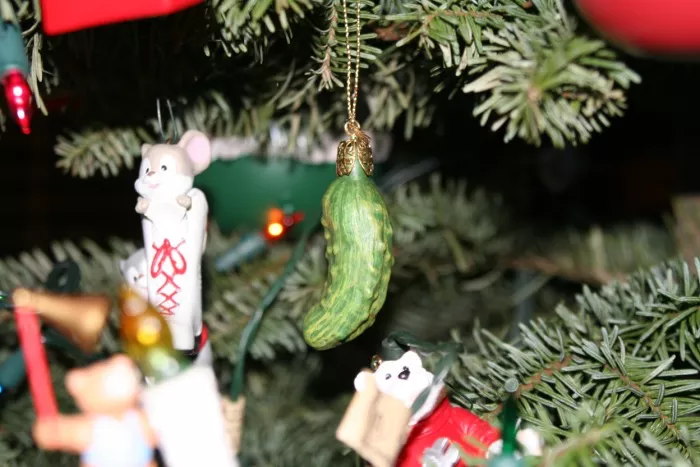The Christmas season is a time of joy, family gatherings, and cherished traditions. While some customs are globally recognized, there are also unique and intriguing traditions that vary from region to region. One such tradition that has gained popularity in recent years is the Christmas pickle. This beloved holiday ornament has captured the imagination of many, sparking curiosity and enthusiasm among those who celebrate Christmas. In this article, we will delve into the fascinating history, symbolism, and practices surrounding the Christmas pickle, uncovering the secrets of this cherished holiday tradition.
I. The Origins of the Christmas Pickle
To truly understand the Christmas pickle tradition, we must first explore its origins. While there are multiple theories about its inception, it’s important to recognize that the Christmas pickle is not as ancient as some other Christmas customs. In fact, its roots can be traced back to the 19th century in Germany.
Germany: The Birthplace of the Christmas Pickle
The Christmas pickle is believed to have originated in Germany, where it is known as “Weihnachtsgurke.” This German tradition involves hanging a pickle-shaped ornament on the Christmas tree. The precise origin story is a matter of debate, with several colorful legends surrounding its creation.
One popular legend suggests that the Christmas pickle tradition began with a German-born American soldier during the Civil War. According to this story, a soldier of German descent, imprisoned in a Confederate prison camp, begged for a pickle as his last meal before succumbing to starvation. His request was granted, and the pickle allegedly gave him the strength to carry on, ultimately leading to his release. Once he returned home, he began the tradition of hiding a pickle ornament on the Christmas tree as a symbol of good luck and gratitude.
Another legend attributes the Christmas pickle to St. Nicholas himself. It is said that St. Nicholas rescued two boys who had been trapped in a pickle barrel for seven years. In gratitude, these boys continued the tradition of hanging a pickle ornament on their Christmas tree every year.
While the true origin remains a mystery, there’s no doubt that the Christmas pickle has deep ties to German culture and Christmas traditions. Today, it is celebrated not only in Germany but also in various parts of the world, including the United States.
II. The Symbolism of the Christmas Pickle
The Christmas pickle, like many holiday traditions, carries a rich symbolism that adds depth and meaning to the festivities. While the symbolism can vary from one family to another, there are some common themes associated with this quirky custom.
A. Luck and Good Fortune
One of the most prevalent interpretations of the Christmas pickle tradition is its association with luck and good fortune. Many families believe that the first person to spot the hidden pickle ornament on the tree will be blessed with good luck for the coming year. This element of surprise and competition adds an exciting dimension to the holiday celebrations, as family members search the tree in anticipation of finding the elusive pickle.
B. Promoting Unity and Family Bonding
The Christmas pickle tradition also emphasizes the importance of family togetherness. As families gather around the Christmas tree, the search for the hidden pickle becomes a shared activity that promotes unity and bonding. It encourages family members to work together, fostering a sense of cooperation and camaraderie.
C. A Touch of Whimsy
In addition to its deeper symbolism, the Christmas pickle also adds a touch of whimsy and playfulness to the holiday season. The idea of hiding a green, pickle-shaped ornament among the branches of a Christmas tree is delightfully quirky, bringing smiles and laughter to both children and adults alike.
III. The Christmas Pickle in America
The Christmas pickle tradition made its way to the United States with German immigrants in the 19th century. Over the years, it has evolved and taken on new dimensions, becoming a cherished part of American holiday celebrations.
A. Early German-American Influence
German immigrants who settled in the United States brought their cherished Christmas traditions with them, including the Christmas pickle. In the late 19th and early 20th centuries, German-American communities celebrated the Christmas pickle tradition with enthusiasm. It is during this period that the legend of the Civil War soldier and the Christmas pickle gained popularity, contributing to the spread of the tradition.
B. The Resurgence of the Christmas Pickle
While the Christmas pickle tradition waned in popularity during the mid-20th century, it experienced a resurgence in the late 20th and early 21st centuries. This revival can be attributed to several factors, including increased interest in holiday traditions, nostalgia for simpler times, and the appeal of quirky and unique customs.
C. Regional Variations
In the United States, the Christmas pickle tradition has taken on various regional variations. Some families choose to hide the pickle ornament on Christmas Eve, while others incorporate it into their Christmas morning celebrations. Additionally, some regions have embraced the tradition more enthusiastically than others, with certain areas holding Christmas pickle festivals and competitions.
IV. How to Celebrate the Christmas Pickle Tradition
Now that we’ve explored the origins and symbolism of the Christmas pickle, let’s dive into the practical aspects of celebrating this unique holiday tradition.
A. Choosing the Pickle Ornament
The first step in celebrating the Christmas pickle tradition is to choose the perfect pickle ornament. These ornaments are typically made of glass or plastic and come in various sizes and shades of green. Some pickle ornaments are even scented to mimic the aroma of a real pickle. When selecting your pickle ornament, consider the size of your Christmas tree and your personal preferences for ornament aesthetics.
B. Hiding the Pickle
The heart of the Christmas pickle tradition lies in hiding the pickle ornament on the Christmas tree. This can be a fun and creative endeavor for families to enjoy together. Here are some tips for hiding the pickle:
Choose a strategic location: Place the pickle ornament in a spot that is not too obvious but still within view of all family members. Consider tucking it behind other ornaments or nestled among the tree’s branches.
Keep it a secret: The location of the pickle should be a well-guarded secret until the time comes to search for it. Only one person, often the one responsible for hiding it, should know its whereabouts.
Establish the rules: Before beginning the search, establish clear rules for finding the pickle. For example, you can decide that the person who finds it gets a special reward or privilege.
C. The Search for the Christmas Pickle
Once the pickle is hidden, the search begins. Family members take turns looking for the pickle ornament among the branches of the Christmas tree. It’s important to maintain a sense of excitement and suspense during the search, as finding the pickle is believed to bring good luck for the upcoming year.
D. The Winner’s Reward
Traditionally, the person who finds the Christmas pickle is rewarded with a small gift or special privilege. This reward can vary from family to family and may include items like a small toy, a special treat, or the honor of opening the first present. The element of surprise and anticipation adds an extra layer of excitement to the tradition.
Conclusion
In the world of holiday traditions, the Christmas pickle stands out as a quirky, heartwarming, and enduring custom. Its origins may be shrouded in mystery, but its significance is clear: the Christmas pickle symbolizes luck, gratitude, and family togetherness.

























